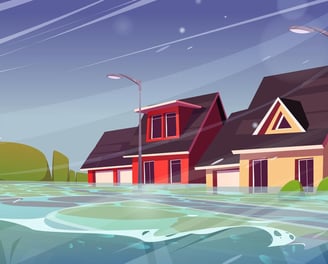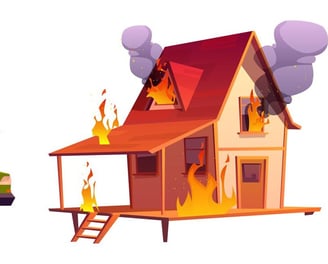Escape Hazards
If your location becomes unsafe (e.g., fire, collapsing structures), plan alternative exits in advance. When escaping a hazardous situation during a war, conflict, or natural disaster, it's crucial to recognize and avoid hazards that could jeopardize your safety. Proper planning and vigilance can significantly reduce the risks associated with escape.
PRIORITIZE SAFETY AND SHELTER
12/28/20243 min read
Our services
If your location becomes unsafe (e.g., fire, collapsing structures), plan alternative exits in advance. When escaping a hazardous situation during a war, conflict, or natural disaster, it's crucial to recognize and avoid hazards that could jeopardize your safety.
Proper planning and vigilance can significantly reduce the risks associated with escape.


1. Types of Escape Hazards
A. Environmental Hazards
Rubble and Debris
Collapsed buildings or infrastructure may block paths or cause injuries.
Mitigation: Wear sturdy footwear, use gloves, and carry a stick to probe unstable areas.
Flooded Areas
Risk of drowning, electrocution, or waterborne diseases.
Mitigation: Avoid crossing moving water and use flotation devices when necessary.
Fire or Smoke
Can block escape routes, cause suffocation, or burn injuries.
Mitigation: Stay low to the ground to avoid inhaling smoke and cover your nose and mouth with a damp cloth.
Extreme Weather
Exposure to cold, heat, or storms can lead to hypothermia or heatstroke.
Mitigation: Dress appropriately, stay hydrated, and seek shelter as needed.
B. Human-Caused Hazards
Checkpoints or Armed Groups
May pose risks if you're suspected of being an enemy or carrying valuable items.
Mitigation: Be polite, comply with instructions, and avoid suspicious behaviour.
Crowds and Riots
Crowded areas can lead to stampedes, theft, or violence.
Mitigation: Stay on the outskirts of crowds and avoid confrontation.
Landmines or Explosives
Common in war zones and abandoned conflict areas.
Mitigation: Stick to marked or well-traveled paths and avoid touching unfamiliar objects.
C. Navigational Hazards
Unfamiliar Terrain
Getting lost in forests, mountains, or deserts can be fatal.
Mitigation: Carry maps, a compass, or GPS and stick to familiar routes if possible.
Blocked Roads
Bridges, tunnels, or highways may be destroyed or inaccessible.
Mitigation: Identify alternate routes and practice navigating them beforehand.
2. Recognizing Hazards in Real-Time
A. Observation
Regularly scan your surroundings for potential dangers like damaged buildings, suspicious individuals, or natural threats.
B. Listening
Be alert for warning sounds like gunfire, explosions, or weather alerts.
C. Smelling
Detect fire, gas leaks, or other chemical hazards early by staying alert to unusual odours.
3. Strategies for Avoiding Hazards
A. Timing
Travel During Low-Risk Hours: Move at night or early morning when visibility and human activity are minimal.
B. Route Planning
Multiple Escape Paths: Have several pre-identified routes to avoid being trapped.
Avoid High-Risk Zones: Stay away from known conflict areas, industrial sites, or heavily surveilled areas.
C. Camouflage
Blend in with your surroundings by wearing neutral colours and avoiding items that draw attention.
4. Preparation to Minimize Risks
A. Equipment
Protective Gear: Sturdy shoes, gloves, and helmets to prevent injuries.
Navigation Tools: Maps, GPS devices, or compasses to stay on course.
First Aid Kits: For treating minor injuries during escape.
B. Training
Drills: Practice evacuations to familiarize yourself with routes and emergency procedures.
Skills: Learn basic first aid, self-defence, and survival skills like water purification.
C. Communication
Stay Informed: Monitor local news or alerts to stay updated on hazards.
Group Coordination: Maintain clear communication with your group to avoid separation or missteps.
5. Tips for Escaping Safely
Travel Light
Carry only essentials to move quickly and avoid fatigue.
Move Quietly
Minimize noise to avoid attracting attention.
Stick to Shadows
Use natural cover like walls, trees, or vegetation to remain inconspicuous.
Avoid Panic
Stay calm to make rational decisions and conserve energy.
6. Common Mistakes to Avoid
Ignoring Warning Signs
Overlooking smoke, unstable structures, or suspicious individuals can lead to preventable accidents.
Overloading Yourself
Carrying too much slows you down and increases exhaustion.
Taking Unfamiliar Routes
Venturing into unknown areas without preparation can increase the risk of getting lost or encountering hazards.
Overestimating Safety
Assuming an area is safe without scouting or verifying it can lead to unexpected dangers.
7. Post-Escape Safety
A. Assess Injuries
Treat wounds or injuries sustained during escape promptly.
B. Reassess Shelter
Ensure your new location is safe and secure before settling.
C. Monitor Updates
Stay informed about ongoing risks or opportunities to relocate to safer areas.
Escape hazards pose significant risks during crises, but with proper preparation, vigilance, and adaptive strategies, you can minimize danger and enhance your chances of reaching safety. Understanding potential threats and staying calm under pressure are your best tools for survival.










